Electrochemical Organic Synthesis
IF 2.3
4区 化学
Q2 CHEMISTRY, ORGANIC
引用次数: 0
Abstract
The potential of electrochemical organic synthesis in achieving sustainable and efficient chemical syntheses, while offering unique reactivity and selectivity, makes it a promising avenue for addressing the challenges in synthetic organic chemistry. The past two decades have witnessed a remarkable advancement in organic electrochemistry, primarily due to the influx of passionate and innovative scientists. These trailblazers, armed with their unique perspectives, are driving the field into uncharted territories, often surpassing the visions of the early pioneers. Their groundbreaking work is carving out new frontiers and making significant scientific impacts, which are aptly highlighted in this special issue. Their pioneering contributions are projected to extend the core foundation of electrochemistry and usher in transformative insights. The articles featured in this special issue on electrochemical organic synthesis are the result of a diverse array of authors hailing from countries across the globe, including Brazil, Canada, China, France, Italy, Japan, Portugal, and the United States. This variety exemplifies the widespread adoption and universal appeal of electrochemistry in the realm of synthetic organic chemistry, confirming its global recognition and relevance within the international scientific community. In this special issue, a selection of review papers vividly illuminates the latest advancements and emerging topics in electrochemical organic synthesis. He, Pan and colleagues explore the evolution of spirocyclic compound construction via electrochemical synthesis strategies since 2000.1 Kong, Cao, and colleagues shed light on recent progress in electro-, photo-, and photoelectrochemical applications of quaternary ammonium salts.2 Qin, Li and co-workers present an indepth review of electrochemical difunctionalization of alkenes.3 Lu and his team delve into transition-metal electrochemical asymmetric catalysis including the recently emerged photoelectrochemical asymmetric catalysis (PEAC).4 Phillips, Pombeiro, and associates encapsulate the power of electrochemistry in catalytic enantioselective synthesis.5 Zhang, Liu, and their team offer a comprehensive summary of electrochemical cascade cyclization reactions used in carbon ring and heterocycle production.6 Mo and his team succinctly overview the latest breakthroughs in high-throughput experimentation technology for electrosynthesis.7 Gui and his team have provided a comprehensive summary of halogen-mediated electrochemical transformations of sulfur-containing compounds.8 Lastly, Chen and his team delve into the fascinating topic of photoelectrochemical cerium catalysis in their detailed review.9 Moreover, an assortment of research papers exhibits the cutting-edge methods and techniques in the field. A notable contribution from Charette, Poisson, Jubault, and their team delineates the synthesis of cyclopropylamines from the corresponding amides through a bromide-mediated, electroinduced Hofmann rearrangement.10 Mitsudo, Suga and colleagues described a bromide-mediated electrochemical cross-coupling reaction between arylboronic esters and aryllithiums.11 Zhang and associates presented a report on nickel-catalyzed electrochemical cyclizative carboxylation of alkene-tethered carbamoyl chlorides with atmospheric carbon dioxide.12 Powers and his team provided electroAuthor Information电化学有机合成
电化学有机合成在实现可持续和高效的化学合成方面的潜力,同时提供独特的反应性和选择性,使其成为解决合成有机化学挑战的有希望的途径。过去的二十年见证了有机电化学的显著进步,主要是由于充满激情和创新的科学家的涌入。这些开拓者以其独特的视角武装自己,将这个领域推向未知的领域,往往超越了早期开拓者的视野。他们开创性的工作开辟了新的领域,并产生了重大的科学影响,这在本期特刊中得到了恰如其分的强调。他们的开创性贡献预计将扩展电化学的核心基础,并带来变革性的见解。这期关于电化学有机合成的特刊的文章是来自全球各国的不同作者的结果,包括巴西、加拿大、中国、法国、意大利、日本、葡萄牙和美国。这种多样性体现了电化学在合成有机化学领域的广泛采用和普遍吸引力,证实了其在国际科学界的全球认可和相关性。在这期特刊中,精选的综述论文生动地阐述了电化学有机合成的最新进展和新兴主题。自2000年以来,He, Pan等人通过电化学合成策略探索了螺旋环化合物结构的演变。Kong, Cao等人介绍了季铵盐在电、光、光电化学应用方面的最新进展秦、李等人对烯烃的电化学双官能化进行了深入的综述Lu和他的团队深入研究过渡金属电化学不对称催化,包括最近出现的光电电化学不对称催化(PEAC)Phillips, Pombeiro和他的同事们概括了电化学在催化对映选择性合成中的作用Zhang, Liu和他们的团队对用于碳环和杂环生产的电化学级联环化反应进行了全面的总结Mo和他的团队简要概述了电合成高通量实验技术的最新突破Gui和他的团队提供了含硫化合物的卤素介导的电化学转化的全面总结最后,Chen和他的团队在他们的详细回顾中深入研究了光电电化学铈催化的迷人主题此外,各种各样的研究论文展示了该领域的前沿方法和技术。Charette, Poisson, Jubault和他们的团队的一项显著贡献描述了通过溴化物介导的电诱导霍夫曼重排,从相应的酰胺合成环丙胺Mitsudo, Suga和他的同事描述了一种溴化物介导的芳硼酯和芳锂之间的电化学交叉偶联反应张和他的同事发表了一篇关于镍催化烯烃系脲酰氯与大气二氧化碳的电化学环化羧基化的报告鲍尔斯和他的团队提供了电子作者信息
本文章由计算机程序翻译,如有差异,请以英文原文为准。
求助全文
约1分钟内获得全文
求助全文
来源期刊

Synthesis-Stuttgart
化学-有机化学
CiteScore
4.50
自引率
7.70%
发文量
435
审稿时长
1 months
期刊介绍:
SYNTHESIS is an international full-paper journal devoted to the advancement of the science of chemical synthesis. It covers all fields of organic chemistry involving synthesis, including catalysis, organometallic, medicinal, biological, and photochemistry, but also related disciplines. SYNTHESIS provides dependable research results with detailed and reliable experimental procedures and full characterization of all important new products as well as scientific primary data.
 求助内容:
求助内容: 应助结果提醒方式:
应助结果提醒方式:


